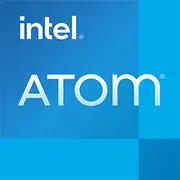Intel Atom Z2560

Intel Atom Z2560: An Obsolete Chip for Basic Tasks in 2025
Overview of Architecture, Performance, and Use Cases
Introduction
The Intel Atom Z2560 is a processor released in 2013 as part of the Clover Trail platform. Despite its venerable age, some budget devices still use it due to its extremely low cost. In 2025, this chip seems anachronistic, yet it remains an interesting example of the evolution of mobile technologies. Let’s explore who might still find it useful today.
Architecture and Technology Process
Clover Trail Features
- Technology Process: 32 nm – an outdated standard (modern chips use 5–7 nm).
- Cores and Threads: 2 cores, 2 threads. Lacks Hyper-Threading, which limits multitasking.
- Frequencies: Base frequency – 1.6 GHz, turbo mode – up to 1.8 GHz. There’s no headroom for significant acceleration.
- Graphics: SGX 544MP2 (PowerVR) with a frequency of 400 MHz. Supports basic APIs like OpenGL ES 2.0 and DirectX 9, but struggles with modern games.
Cache: Only 1 MB of L2 cache – a minimum even for office tasks.
Memory Support: Single-channel LPDDR2-1066. Maximum 2 GB of RAM – critical for Windows 10/11, but acceptable for lightweight Linux distributions.
Power Consumption and TDP
- TDP 3 W: The main advantage of the chip. Suitable for passive cooling, which reduces noise and the cost of devices.
- Power-Saving Modes: Intel SpeedStep reduces the frequency to 600 MHz during idle.
Comparison with Modern Chips:
- Apple M2 (5 nm, TDP 15 W) – offers 5 times the performance with a 5 times higher TDP.
- Qualcomm Snapdragon 8cx Gen 4 (4 nm) – TDP 7 W, but supports 5G and AI acceleration.
The Atom Z2560 even lags behind budget ARM chips from 2025, such as MediaTek Kompanio 820 (6 nm, 4 W).
Performance in Real Tasks
Office Work
- Microsoft Office 2025: Running Word or Excel is possible, but delays occur when dealing with spreadsheets containing over 1000 rows.
- Web Surfing: Browsers (Chrome, Edge) lag when more than 5 tabs are open. It is advisable to use Firefox with ad-blocking extensions.
Multimedia
- Video: Streaming 1080p (YouTube) spikes CPU load to 80-100%. 4K is not supported.
- Audio: Background processing – no problems.
Gaming
- Old Games: Half-Life 2 (2004) – 30-40 FPS on low settings.
- Indie Projects: Stardew Valley – 50-60 FPS.
- Modern Games: Even Among Us (2018) lags due to weak graphics.
Turbo Boost: An increase of up to 12% (1.8 GHz) yields minimal effects. The mode is rarely activated due to thermal limitations.
Use Cases
Who Might Find Z2560 Relevant in 2025?
1. Ultra-Budget Laptops: Devices priced at $150–200 (e.g., TrekStor SurfBook).
2. Specialized Gadgets: Hotel terminals, info kiosks.
3. Educational Projects: E-books using Linux (Lubuntu).
Not Suitable For:
- Graphic work (Photoshop, Blender).
- Running Windows 11 (requires TPM 2.0 and Secure Boot).
Battery Life
- Operating Time: 8-10 hours on devices with a 30–40 Wh battery (e.g., ASUS Transformer Book).
- Power-Saving Technologies:
- Disabling unused cores.
- Adaptive screen dimming.
Tips:
- Disable Wi-Fi and Bluetooth in reading mode.
- Use dark themes to reduce display load.
Comparison with Competitors
Analogues from 2013–2015
- AMD A4-1200: TDP 3.9 W, graphics Radeon HD 8180. Better in gaming but rare.
- Apple A7 (iPhone 5s): 64-bit architecture, higher IPC, but only for mobile devices.
Modern Competitors (2025)
- Intel N200 (7 nm): TDP 6 W, 4 cores, AV1 support – 3 times faster.
- MediaTek Kompanio 500: $250 laptops with 8 GB of RAM and 10-hour battery life.
Pros and Cons
Strengths:
- Device price: $150–300.
- Silent operation (no fan).
- Compatibility with Windows 10 and Linux.
Weaknesses:
- Weak performance.
- No support for modern standards (USB 3.0, Wi-Fi 6).
- Limited upgradeability: RAM and SSD are often soldered to the motherboard.
Device Selection Recommendations
Types of Gadgets:
- Ultra-Budget Laptops: For example, Chuwi HeroBook (price: $199).
- Tablets with Keyboards: Lenovo Yoga Tablet 2 (used – $80, new models are no longer being produced).
What to Look For:
1. Screen: IPS display at least 11.6" (1366x768).
2. Storage: Must be SSD (even 64 GB).
3. OS: Preferably Linux (Manjaro XFCE) or Windows 10 LTSC.
Avoid:
- Devices with HDD.
- Models without a warranty (often low-quality builds).
Final Conclusion
The Intel Atom Z2560 in 2025 is a choice for those who need a cheap device for basic tasks:
- Pros: Cost, quiet operation, compatibility with lightweight OS.
- Cons: Outdated architecture, limited performance.
Who is it suitable for:
- Students for note-taking.
- Users needing a “typewriter” for documents.
- Enthusiasts building retro gadgets.
Alternatives: If your budget allows $300+, consider laptops with Intel N200 or AMD Mendocino — they will provide a buffer for the future.
Example of a Device from 2025:
- Acer Cloudbook 11 (Z2560, 4 GB RAM, 128 GB SSD) – $179. Suitable for working with Google Docs and watching YouTube.
If you’re not ready to deal with lag – increase your budget. However, for minimal tasks, the Atom Z2560 can still be justified.
Basic
CPU Specifications
Memory Specifications
GPU Specifications
Benchmarks
Compared to Other CPU
Share in social media
Or Link To Us
<a href="https://cputronic.com/cpu/intel-atom-z2560" target="_blank">Intel Atom Z2560</a>